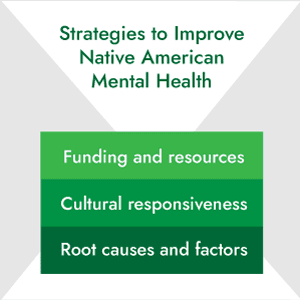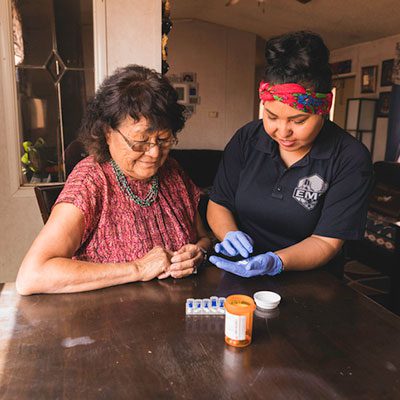Native American communities are facing a mental health crisis that is largely overlooked and under-addressed. According to the U.S. Department of Health and Human Services, the American Indian/Alaska Native (AI/AN) demographic has higher rates of mental health conditions, such as depression, anxiety, post-traumatic stress disorder, suicide, and substance use disorders, than the general population. These problems are often linked to historical trauma, discrimination, and poverty. Many Native Americans also experience cultural disconnection, isolation, loss of identity, and domestic violence. With so many contributing factors, how can the U.S. find strategies for healing Native American mental health?
Adding to the challenge, many Native Americans with mental health conditions do not seek help. Deterrents include the stigma that surrounds mental illness and a lack of cultural sensitivity in many mental health services, which may not respect or align with Native American values, beliefs, and traditions. Another barrier to healing is that many Native Americans do not have access to affordable, accessible, or adequate mental health resources, especially in rural and remote areas.
Strategies to improve Native American mental health
Improving mental health in Native American communities is a complex challenge that requires efforts on many levels — federal, tribal, and in health care. Strategies generally fall into three categories:
Increasing funding and resources
 One of the most urgent and effective strategies for improving mental health in Native American communities is to increase funding and resources for mental health programs and services at both the federal and tribal levels. Tactics to address the need for resources include advocating for more equitable and adequate allocation of funds, streamlining and simplifying administrative and regulatory processes, and improving the accountability and transparency of funding agencies. Additionally, increasing the availability and affordability of health insurance and reducing out-of-pocket costs for Native Americans improves the access and utilization of mental health services.
One of the most urgent and effective strategies for improving mental health in Native American communities is to increase funding and resources for mental health programs and services at both the federal and tribal levels. Tactics to address the need for resources include advocating for more equitable and adequate allocation of funds, streamlining and simplifying administrative and regulatory processes, and improving the accountability and transparency of funding agencies. Additionally, increasing the availability and affordability of health insurance and reducing out-of-pocket costs for Native Americans improves the access and utilization of mental health services.
Enhancing cultural competence and responsiveness
Another key strategy for improving mental health in Native American communities is to enhance the cultural competence and responsiveness of mental health providers, programs, and services — both within and outside tribal settings. Tactics include increasing the recruitment, retention, and training of mental health professionals who can provide culturally appropriate and respectful care by integrating Indigenous knowledge, values, and practices such as traditional healing methods, spirituality, and community involvement. Reducing the stigma and discrimination associated with mental health issues and promoting awareness and education among Native American communities and the public can also foster a more supportive and inclusive environment for Native American mental health.
Addressing root causes and risk factors
Perhaps the most important strategy for improving mental health in Native American communities is to address the root causes and risk factors that contribute to mental health disorders, substance abuse, suicide, and trauma by implementing preventive and protective measures that target the social, economic, political, and cultural determinants of health. Efforts include improving living conditions, opportunities, and rights for Native Americans in the following areas:
- poverty reduction
- employment creation
- education access
- housing quality
- environmental protection
- violence prevention
- substance abuse treatment
- historical trauma healing
- cultural preservation
- identity affirmation
Strengthening the resilience, coping, and empowerment of Native Americans, especially youth, elders, and women, can enhance the mental health and well-being of these communities.

How healthcare providers can support Native American mental health
With the daunting challenge of repairing centuries of harm brought onto Native American communities, it is difficult to determine where to start. There is a major need for better mental health services, better access to urgent mental health help and crisis care, and a more holistic approach to mental health that integrates culturally sensitive mental health care into all care areas. But it is helpful to recognize that each of the three major strategy areas discussed above can take place on many different levels — including right where you are.
Community education for suicide prevention
Community education can have a big impact on increasing the capacity for suicide prevention and crisis intervention. Teaching people about suicide and how to interact with and help people in need means more people will receive a rapid and potentially lifesaving response.
Mental Health First Aid
Mental Health First Aid (MHFA) is an eight-hour training program for healthcare providers and community members that teaches about mental health crises, suicide prevention, and how to therapeutically respond to an individual in crisis. Created by the National Council for Mental Wellbeing, it is based on the idea that just as physical first aid can save lives, so can first aid for mental health. MHFA aims to reduce stigma, increase awareness, and provide support to those who may be struggling with mental health issues.
The program trains participants to use the ALGEE action plan:
- Assess for risk of suicide or harm.
- Listen.
- Give reassurance and information.
- Encourage appropriate professional help.
- Encourage self-help and other support strategies.
Question, Persuade, Refer
Another way to raise awareness about suicide and teach community-centered suicide prevention is through a much shorter virtual course, Question, Persuade, Refer (QPR). Although not as in-depth as MHFA, QPR helps participants feel confident and prepared to apply what they learn to potential future situations.
With every mental health curriculum intended for a Native American audience, it is important to provide support that aligns with the community’s needs and preferences — such as traditional healing practices, storytelling, and spirituality — and respects the community’s values and beliefs. Instructors should share information and referrals for culturally appropriate and accessible local mental health resources.
Additional resources
- If you or someone you know is struggling with mental health, you can refer them to the 988 Suicide and Crisis Lifeline. They can call 988 to receive confidential support and resources. Professionals helping others can also receive information and support.
- The Substance Abuse and Mental Health Services Administration (SAMHSA) provides a 988 Partner Toolkit that tribes can use to communicate about the 988 Suicide and Crisis Lifeline.
- The National Indian Council on Aging, Inc. provides information about Hope for Life Day, which originated in 2015 to raise awareness about Native American suicide.
- The National Action Alliance for Suicide Prevention provides the Hope for Life Day Toolkit and the Hope for Life Day Toolkit: Tips and Strategies for Engaging Tribal Leaders to support awareness efforts.
How Relias supports Native American mental health improvement
Regardless of which strategies your organization adopts to help improve mental health and suicide prevention in Native American communities, the primary goals are to continue to raise awareness and persistently prioritize improvement initiatives — both large and small. Whether you are helping an individual, a community, or an entire population, every effort can make a difference.
All initiatives should begin with education, which empowers patients, providers, and healthcare organizations to understand the scope of the issues, target the most effective ways to move forward, and accurately measure progress.
With our award-winning, accredited content, Relias empowers your healthcare organization to provide culturally sensitive, trauma-informed care. A deep understanding of the issues creates a solid foundation for improvement.

Evidence-Based Healthcare Training Solutions
Relias can help your organization with our proven, data-driven solutions. We support your clinicians on their journey to competency — and your organization’s ability to provide the best possible care and continuously improve patient outcomes.
Explore solutions →





